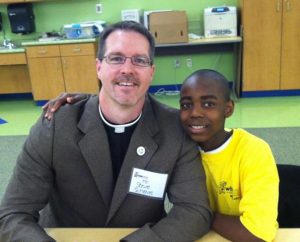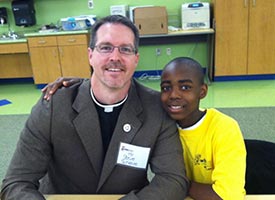By Vicki Biggs
“For all it looks bad, it’s a bright spot. The fields are ripe.” So says the Rev. Terry Cripe, president of the LCMS Ohio District, regarding ministry among urban and inner-city neighborhoods.
Cripe spoke with Reporter about LCMS Urban & Inner-City Ministry (UICM), a mission focus re-energized by the recent appointment of the Rev. Steve Schave as its new director. The ministry works to advance revitalization in city ministries, most of which are multiethnic. Through UICM, local congregations are equipped for community engagement with the goal of providing a spiritual home for people who are searching for hope and healing.

There is a desperate need for ministry focused on urban and inner-city settings because it is an area where many congregations have little experience, Cripe said. “The cities are where people congregate, but they are people who generally are not typical of those who attend our suburban congregations.”
The Rev. Bart Day, executive director of the LCMS Office of National Mission, which oversees UICM, agreed. “ The LCMS must engage in our cities,” he said. “The significant population increases in the U.S. are happening in our cities. The church needs to be where the people are.”
Cripe is pleased to see that Schave — who most recently served an Ohio District congregation and as the district’s third vice-president — is the director of UICM. “In addition to a solid theological education, Steve has a great entrepreneurial spirit,” he said. “He knows how to get people to collaborate and come together in a great team effort.”
Schave served as pastor for revitalization at St. Paul Lutheran Church, Cincinnati, from 2008 to 2012. This historic congregation, founded in 1868, had flourished for decades: preaching the Word, planting new congregations, teaching the faith through its parochial school, and standing strong in its confession. But in more recent years, the church and the surrounding community had fallen upon difficult straits. Originally founded in a thriving rural community, the environs of Cincinnati grew to encompass the parish. The makeup of the city changed. Economies ebbed. The school closed. There were divisions among congregation members.
This is the setting into which Schave entered. He asked himself, “What would be a good first small step toward reaching out and reuniting the congregation?” The answer: He organized a mission trip to Africa – to provide basic human care and help construct a building for a new Lutheran church. The names of his congregation and that of the African congregation would be etched together into the foundation of the new building.
“That was the turning point for St. Paul,” Schave said. “We all felt that if we could come together to serve our neighbor on the other side of the globe, the possibilities in our own backyard were endless. Within a few months, we were planning our first Christmas Day dinner to serve those who were hungry or alone in our community.”
Cripe added that under Schave’s leadership, the congregation made great strides toward recovering its lost vision. “Steve did a great job partnering with civic entities and leading rehabilitation that benefited the whole community. Today there is a master plan for the neighborhood that includes new buildings and beautification work. Across the street from St. Paul’s, a derelict apartment complex known as the ‘Devil’s playground’ that was the scene of drug deals and murders has been demolished. The congregation supports a retirement community — a HUD facility named St. Paul’s Village — on its property and is doing great work to serve the elderly. This all is the result of Steve’s leadership.”
As the congregation’s members came together to work on these many efforts, their fellowship grew, Schave said. New faces from the community began to appear at Sunday services and adult confirmation classes blossomed. More young people began participating in youth events, and Schave attributes a renovated gym at St. Paul’s to attracting at-risk children and others in need. “But,” he said, “perhaps a TV news reporter covering our Christmas Day dinner said it best, ‘Rich and poor, black and white, breaking bread together on Christmas Day, they are doing things right … at St. Paul Lutheran Church.’ I thank God for what we were able to do — with His help — together.”
“We are living in a time when many cities are outgrowing their suburbs, and yet they are plagued with poverty and crime, and the numbers are mounting of those falling away from the Word of God,” Shave added. “The footprint of the church is shrinking as the streets grow dim. What an opportunity we have, in a distinctly Lutheran way, to bring Christ back to our cities.”
Many people who immigrate to the U.S. gravitate to cities.
“It’s a pure matter of economics, jobs, housing and educational opportunities,” said the Rev. Doug Kallesen, executive director of outreach for the LCMS Florida-Georgia District, which includes five major urban centers. “Those who move to the U.S. settle where there is more of their same people group. And not just ones or twos — they look for growing or established clusters or communities of people from their home countries.”
“There’s definitely a need for urban ministry,” Kallesen added. “It’s an area where many churches are looking not to thrive, but to survive. They need help to reach people and connect them to Jesus. Here’s the danger if we don’t do this ministry: Many immigrants come to the U.S. with no faith or other beliefs. If they live without the Gospel, they will affect lives and influence others they come in contact with non-Christian thinking and values. And if they die without the Gospel, they are lost.”
Kallesen looks forward with good hope for the future of UICM. “Steve is experienced in this journey and has the background from the parish that is necessary,” he said. “He has a passion for people that meets them where they are, which will serve us well as he shares the love of Christ through this ministry.”
Schave served as mission developer and pastor at Christ Lutheran Church, Perry, Ga., from 2005 to 2008. The new congregation was planted in a tourism center where Lutheranism was unknown. But Schave worked to build the congregation’s life together, and he became active in hospital, nursing home and prison ministry. He and his wife, Kim, a trained deaconess, led the congregation to develop “Thee Lord’s Table,” a feeding ministry for the community’s homeless and disadvantaged that grew into a community center. They also became active in a local shelter for pregnant or abused women and children.
“Today, Christ Lutheran is going strong,” Kallesen said, “The congregation has built its first building and is going to add an assisted-living center on the property. This is phase two of the church’s plan and part of Steve’s original vision.”
Kallesen hopes the Synod’s UICM ministry will focus on listening, learning and exploring together solutions and strategies for ministering among those who live in urban centers. “In partnership together, we should be able to see what the Lord is doing and be better able to connect with His plans,” he said.
A key goal, Kallesen said, is to better connect with city leaders and residents. “We need to be on the same page as the people we are ministering among. We have to be able to present our message in a context they can hear.”
Cripe added, “Many populations in inner cities are struggling … to find good-paying jobs, quality housing … basically to provide and care for their families. Many have little hope. The Gospel can give hope and change people’s perspectives.”
As far as the ability of UICM to help congregations be better equipped for urban and inner-city ministry, Cripe is hopeful for the future. “Steve is a wise choice for leading LCMS Urban & Inner-City Ministry,” he said. “He has a multitude of talents for this ministry, and I pray he will awaken a lot of folks who are mindful of the needs and that we can do more in these ripe fields for mission.”
Vicki Biggs is director, Public Relations for The Lutheran Church—Missouri Synod.
